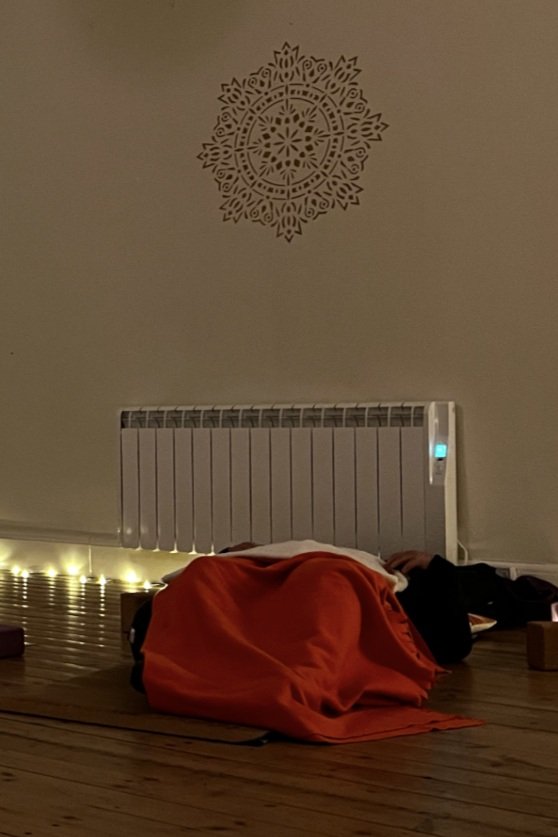Finding Stillness in Yoga and Beyond: The Power of Savasana
In our busy lives, we often rush through tasks, eager to check them off our to-do lists. This sense of urgency can seep into our yoga practice as well, where we may feel the need to “get through” the session, perhaps even skipping the final Savasana (corpse pose) in the rush to move on to the next thing. But it is precisely this urge to hurry that makes the practice of stillness so vital.
Savasana—a pose that might appear simple on the surface—is actually one of the most profound practices in yoga. It is in this stillness, this conscious pause, that we can truly connect with the present moment, quiet the mind, and allow the benefits of our practice to take root.
Why Savasana is Essential
In our fast-paced world, finding stillness is not just a luxury—it’s a necessity. Savasana offers a unique opportunity to experience this stillness at the end of a yoga session. In Savasana, you lie flat on your back, arms relaxed by your sides, legs comfortably apart, and eyes gently closed. While the body remains completely still, the mind is invited to settle into a state of deep relaxation.
For many, the challenge of Savasana lies in quieting the mind, which often continues to chatter away with thoughts, worries, and distractions. This is where the true power of Savasana comes in—it’s an invitation to let go, to release the tension not just in the body, but in the mind as well.
As your teacher guides you into Savasana, it’s important to remember to get comfortable, to find a position where you can fully release into the earth, letting go of any lingering aches or discomforts.
The Philosophy Behind Stillness
The importance of stillness is deeply rooted in yoga philosophy. According to the Yoga Sutras of Patanjali, one of the primary goals of yoga is to achieve "Yogas chitta vritti nirodhah," which translates to the cessation of the fluctuations of the mind. This stilling of the mind is essential for achieving a state of yoga, or union.
Savasana is a powerful practice for cultivating this mental stillness. By lying in stillness at the end of a yoga practice, students are given the space to internalize the physical and mental benefits of the asanas (poses) they’ve performed. It’s a moment of integration, where the body can absorb the practice, and the mind can settle into a state of clarity and calm.
The Science of Stillness
Scientific research supports the benefits of practising stillness through poses like Savasana. Studies have shown that mindful relaxation can significantly reduce stress, improve sleep, and enhance overall well-being. For example, research published in the Journal of Behavioral Medicine highlights how relaxation techniques, such as those practiced during Savasana, can lower cortisol levels—the hormone associated with stress.
Moreover, the practice of stillness activates the parasympathetic nervous system, which helps to lower heart rate, reduce blood pressure, and promote a sense of calm. Neuroscience also tells us that these practices can increase activity in the prefrontal cortex, the part of the brain responsible for decision-making and emotional regulation, leading to improved focus and emotional resilience.
Integrating Stillness Through Asana Practice
Throughout your yoga practice, each movement and pose can be seen as a preparation for Savasana. The asanas are not just about stretching or strengthening the body, but about preparing the mind to find stillness. When we move through our practice with intention and mindfulness, we are training the mind to focus and release distractions, making it easier to settle into stillness during Savasana.
This is why it’s so important not to skip Savasana—it’s the culmination of your practice, where everything comes together. It’s the moment where you allow yourself to simply be, fully present, fully relaxed.
Bringing Stillness into Daily Life
The practice of stillness in Savasana can extend beyond the yoga mat into daily life. Consider how often you allow yourself to truly be still, without the need to do or think about anything. These moments of stillness, however brief, can have profound effects on your mental and emotional well-being.
You can incorporate stillness into your day by taking a few deep breaths before starting a task, enjoying a quiet moment with a cup of tea, or simply pausing to appreciate the present moment. These small acts of stillness can help you cultivate a greater sense of presence and reduce stress, bringing the calm and clarity of Savasana into every aspect of your life.
In Conclusion
Finding stillness is a journey, one that begins on the yoga mat but extends far beyond it. Through the practice of Savasana, you learn to quiet the mind, release tension, and connect with the present moment. This stillness is a gift, one that offers profound benefits for your body, mind, and soul.
As you continue your yoga journey, I encourage you to embrace the stillness that Savasana offers. Remember, it’s in these moments of stillness that you can truly listen—to your body, your heart, and your mind. And in that listening, you find the strength and wisdom to navigate the world with grace and purpose.



